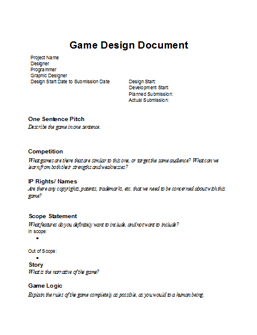Everyone’s a Designer!
Warning: This post contains potentially offensive opinions that may not be shared by everyone affiliated with this Game Jam.
Do I have your attention yet? Good! If it’s your first Game Jam and you’re not a programmer, artist, or musician you’re probably coming as a game designer. This is EXCELLENT! Game design is the coolest job on the planet, and there aren’t enough great ones out there.
But what is a game designer, and what is their role at a Game Jam? First I want to say what a game designer isn’t. A Game Designer isn’t an idea man. I’m going to let that sink in for a second. A Game Designer isn’t an idea man.
The reason this is important to cover is because often times at Game Jams you’ll see people who come as designers and put together a great pitch for a cool idea, then sit back idly, acting like they’ve done their part. These people aren’t designers, they’re dead weight. Ouch! Maybe that’s a bit harsh. I guess it’s possible that they’re designers, but they’re not good designers.
For the sake of this post lets define a game designer as someone who communicates and facilitates their vision of what it will be like to experience a game or game element by drawing from their own personal life experiences and gaming history.
The section of that definition that’s particularly relevant to a Game Jam is the “communicate and facilitate” part. Your role as a designer isn’t to come up with a cool idea – it’s to have an vision of how the core ideas behind the game will manifest themselves as a working entity, and work your booty off to steer the team toward that vision without getting in the way of progress.
You can do this in many ways. One traditional way has been through a design document. Jonathan Leek has provided a version of the IDC Projects design template for Game Jam game designers to use as a basis for communicating their ideas. Here’s a link:
Design Doc Template
I want to caution you that while these CAN work, I’ve found that documentation usually goes unread, especially when there are tight deadlines like those at the Game Jam. Still, filling in this template can help you work through some potential design bottlenecks in advance, so that you’re ready when the questions come flying or can bring these up early to get a team consensus.
Another way is through level design. Depending on the technologies involved and your programmer’s prowess, you might be able to do this through a level editor that your programmer finds or creates. In two previous Game Jams my team’s designers used Tiled to create and iterate on levels without requiring a programmer to personally program in every map element. I’ve also seen teams use 2-color image files to create walls in a maze game. If that isn’t an option, levels can always be created and passed around on graph paper. Remember: anything to help communicate the vision of the game.
One common and extremely useful way designers can help communicate their vision is through art. This can be by finding placeholder art that programmers can use in development and artists can use as templates for their work, or by finding existing works that use the colors and styles that evoke the intended tone of the game. The same goes for music. Find some songs that communicate the tone of the game, or visit a public domain music site full of tracks that can be used by anyone and everyone for free.
And finally, the very best way to communicate a vision of a game is to actively create that vision. It’s daunting, but this means developing it yourself. It’s the way you’ll learn the most and have the most fun. Several tools, such as Game Maker, Stencyl, and Twine can be learned over a weekend and can be used to bring most simple ideas to life. Or you can throw technology out of the window and make a board or card game – because they can be iterated on so quickly, board games are often the most polished games to come out of Game Jams.
Above all, remember that because everyone is a designer, the artists, programmers, and other members of your team are designers as well. Your vision should overlap with theirs to some extent (that’s why you chose to be on the same team), but they’ll have their own interpretation, and that’s ok. Your goal should be to create something and learn stuff while meeting others and having fun.
For now, get some rest. In just a few days you’ll be spending 48 hours building games and making friends.
No comments to show





 Chrome
Chrome Firefox
Firefox Safari
Safari